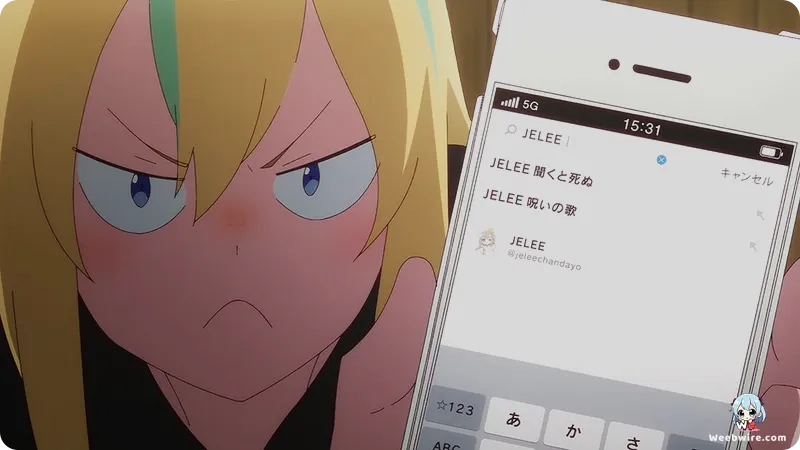From Solitude to Synergy: 'Jellyfish Can’t Swim in the Night' Delivers a Poignant Anthem of Artistic Self-Discovery

“Jellyfish Can’t Swim in the Night” has captivated audiences as a profound exploration of youthful introspection and the arduous journey toward self-discovery. This anime masterfully blends drama, music, and slice-of-life elements, transcending a typical coming-of-age narrative. It delves into the intricate lives of four young women who, much like the series' titular jellyfish, find themselves adrift in the vast, often dark, ocean of modern life. They grapple with navigating their individual paths until they forge a powerful connection, discovering solace and strength through collective creative expression. The title itself serves as a deeply moving metaphor, subtly highlighting the inherent vulnerability and unseen struggles of individuals who, despite their immense potential, may feel lost in their personal challenges, unable to propel themselves forward without external light or meaningful connection.
At the heart of the series is its meticulous character development, particularly evident in its quartet of protagonists: Mahiru Kōzuki, an illustrator battling persistent self-doubt; Kano Yamanouchi, a former idol searching for her authentic voice; Kiui Watase, a VTuber who meticulously conceals her true self; and Mei Takanashi, a prodigious composer with a distinct, often misunderstood, artistic vision. Each character brilliantly embodies a different facet of adolescent anxiety and the universal human desire for genuine connection. The narrative expertly interweaves their individual insecurities and aspirations, illustrating how their initial solitude gives way to a powerful synergy once they unite to form the art group “JELEE.” This creative collective swiftly becomes their sanctuary, a space where they can shed inhibitions and express their deepest emotions through their respective artistic mediums. The anime subtly but powerfully underscores how art, music, and digital performance evolve from mere hobbies into vital lifelines for these characters, enabling them to communicate what words often fail to convey.
The strategic choice of King Records as the animating studio is particularly insightful, leveraging its rich background as a major Japanese record label. This inherent organizational DNA is palpably reflected throughout “Jellyfish Can’t Swim in the Night,” where music is not merely a soundtrack but an integral character in its own right. The series showcases an exceptional dedication to sound design and musical composition, significantly elevating the emotional impact of every scene. Fans frequently commend the intricate layering of musical pieces, with each track seemingly mirroring the internal state or pivotal evolution of the characters. For instance, Kano’s transformative journey from a disillusioned idol to a vocalist embracing her true artistic voice is beautifully underscored by the evolution of her musical style, moving from polished pop to raw, emotionally charged performances. This profound integration of music theory and production quality stands as a testament to King Records' expertise, adding a layer of authenticity rarely achieved in anime where music plays such a central role.

Furthermore, the anime’s visual storytelling is nothing short of breathtaking. The portrayal of Shibuya, especially its nocturnal landscapes, functions not merely as a backdrop but as an active participant in the narrative. The neon-lit streets, the serene quiet corners, and the bustling crowds are rendered with exquisite detail, crafting an atmosphere that perfectly complements the characters’ internal worlds. The striking contrast between the vibrant, often overwhelming urban environment and the quiet, introspective moments of the characters serves to emphasize their initial feelings of isolation and their eventual discovery of belonging. The animation style itself, characterized by fluid movement and highly expressive character designs, allows for a nuanced portrayal of emotions, making the characters’ struggles and triumphs feel incredibly real and relatable. The judicious use of vibrant colors, particularly when the characters are immersed in their creative pursuits, symbolizes their blossoming confidence and the profound joy they find in their shared artistic endeavors.
A captivating, lesser-known detail that amplifies the anime's charm is the subtle symbolism woven into the “jellyfish” motif, extending far beyond the title. Throughout the series, visual cues and thematic parallels liken the girls’ creative process and their burgeoning online presence to the bioluminescence of jellyfish. Just as jellyfish emit light in the dark ocean, the “JELEE” group creates art that shines brightly in the digital night, naturally attracting others who might feel similarly lost. This artistic choice elevates the narrative from a simple slice-of-life story to a poetic meditation on discovering one’s inner light amidst darkness. The series also skillfully plays with the idea of transparency and vulnerability, much like the translucent nature of jellyfish, as the characters gradually open up to each other and to their audience through their authentic art.
The series has resonated deeply with audiences worldwide for its authentic portrayal of the anxieties and aspirations of young people navigating the complexities of the digital age. Many viewers have found profound identification with the characters’ struggles to forge their unique voices and contend with the pressures of online validation. The anime’s powerful and universally applicable message—that it’s perfectly acceptable to be a “jellyfish that can't swim in the night” if you find others to drift with and collaboratively create your own light—transcends cultural boundaries. It celebrates the inherent beauty of imperfection and the immense strength found in genuine collaboration, offering a comforting narrative for anyone who has ever felt out of place. The nuanced exploration of themes such as artistic integrity versus commercial appeal, the ephemeral nature of online fame, and the enduring power of true friendship significantly contributes to its lasting impact. “Jellyfish Can’t Swim in the Night” is far more than just an anime; it is a beautifully crafted testament to the resilience of the human spirit and the transformative power of art, serving as a poignant reminder that even in the deepest night, creativity can illuminate the path forward.
Credits
Jellyfish Can’t Swim in the Night
Author
Kou Shirasaki
Cover Art
Ryohei Takeshita
Studio
King Records
Publisher
King Records
Producers





